Trileptal 60 Mg/Ml Oral Suspension
You can get more information about your epilepsy by contacting these independent patient groups:
Telephone
N.S.E. The National Society for Epilepsy 01494 601400
B.E.A. The British Epilepsy Association 0808 8005050
E.A.S The Epilepsy Association of Scotland 0808 8002200
a
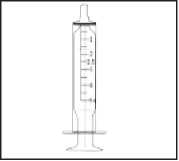

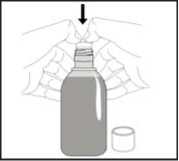
10. Replace the child resistant cap after use, leaving the adapter in place.
11. Cleaning: After use, wipe the outside of the syringe with a dry, clean tissue.
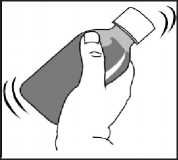
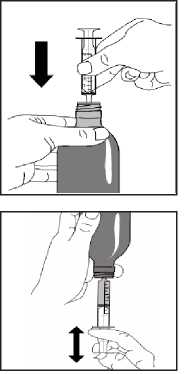
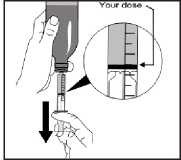
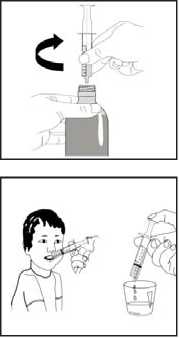
PATIENT INFORMATION LEAFLET Ref 1467/270416/1/F
Trileptal® 60 mg/ml Oral Suspension
(oxcarbazepine)
INSTRUCTIONS FOR USE
Read these instructions carefully so that you
know how to use this medicine.
How to use the medicine kit
There are three parts to the medicine kit:
1. A plastic adapter that you push into the neck of the bottle. The adapter must always stay in the bottle.

2. A bottle containing 250ml of the medicine, with a child resistant cap. Always replace the cap after use.
3. A 10ml oral dosing syringe. This fits into the plastic adapter to withdraw the prescribed dose from the bottle.
How to fit the plastic adapter into a new bottle of medicine
1. Shake the bottle of medicine for at least 10 seconds.
2. Remove the child resistant cap by pushing it down firmly and turning it anti-clockwise (as shown on the top of the cap).
Note: Keep the cap nearby to close the bottle after each use.
3. Hold the open bottle upright on a table. Push the plastic adapter firmly into the neck of the bottle as far as you can.
Note: You may not be able to push the adapter down fully but it will be forced into the bottle when you screw the cap back on.
To dispense a dose, please follow all the instructions in Preparing a dose of medicine.
Preparing a dose of medicine
The medicine can be swallowed directly from the oral syringe, or mixed in a small glass of water.
1. Shake the bottle well.
Prepare the dose immediately afterwards.
2. Push and turn the child resistant cap to open the bottle.
(Always replace the cap after use)
3. Check the plunger is fully down inside the barrel of the oral syringe.
4. Keep the bottle upright and insert the oral syringe firmly into the plastic adapter.
5 . H o l d the oral syringe in place and carefully turn the bottle upside down.
6. Slowly pull the plunger down fully so that the syringe fills with medicine. Push the plunger back up completely to expel any large air bubbles that may be trapped inside the oral syringe.
7. Withdrawing the prescribed dose:
Slowly pull the plunger down. Pull until the top edge of the black ring is exactly level with the marker on the oral syringe barrel that indicates the prescribed dose.
Note: If the prescribed dose is more than 10ml, withdraw the prescribed dose in two steps. Firstly, fill the syringe to the 10 ml mark, and take the 10 ml. Then reload the oral syringe to the required level to take the remaining amount. Ask your pharmacist if you are unsure.
8. Carefully turn the bottle the right way up. Disconnect the oral syringe by gently twisting it out of the plastic adapter.
9. The dose of medicine can be swallowed directly from the oral syringe. The patient must be sitting upright and the plunger must be pushed slowly to allow the patient to swallow. Alternatively, the dose can be mixed in a small glass of water just prior to administration. Stir and drink the entire mixture right away.
Read all of this leaflet carefully before you
start taking this medicine.
• Keep this leaflet. You may need to read it again.
• If you have any further questions, ask your doctor or pharmacist.
• This medicine has been prescribed for you or your child. Do not pass it on to others. It may harm them, even if their symptoms are the same as yours.
• If any of the side effects gets serious, or if you notice any side effects not listed in this leaflet (see section 4) please tell your doctor or pharmacist.
Your medicine is called Trileptal 60 mg/ml Oral
Suspension and will be referred to as Trileptal
throughout the rest of this leaflet.
In this leaflet:
1. What Trileptal is and what it is used for
2. What you need to know before you take Trileptal
3. How to take Trileptal
4. Possible side effects
5. How to store Trileptal
6. Contents of the pack and other information
1. WHAT TRILEPTAL IS AND WHAT IT IS USED FOR
What Trileptal is
The active ingredient of Trileptal is oxcarbazepine. Trileptal belongs to a group of medicines called anticonvulsants or antiepileptics.
What Trileptal is used for
Medicines such as Trileptal are the standard treatment for epilepsy.
Epilepsy is a brain disorder that causes people to have recurring seizures and convulsions. Seizures happen because of a temporary fault in the brain's electrical activity. Normally brain cells coordinate body movements by sending out signals through the nerves to the muscles in an organised, orderly way. In epilepsy, brain cells send out too many signals in a disorderly fashion. The result can be uncoordinated muscular activity that is called an epileptic seizure.
Trileptal is used to treat partial seizures with or without secondarily generalised tonic-clonic seizures.
Partial seizures involve a limited area of the brain, but may spread to the whole brain and may cause a generalised tonic-clonic seizure. There are two types of partial seizures: simple and complex. In simple partial seizures, the patient remains conscious, whereas in complex partial seizures, patients consciousness is altered.
Trileptal works by keeping the brain's “overexcitable” nerve cells under control. This suppresses or reduces the frequency of such seizures.
Trileptal can be used alone or in combination with other antiepileptic medicines.
Usually, the doctor will try to find the one medicine that works best for you or for your child. However, with more severe epilepsy, a combination of two or more medicines may be needed to control seizures.
Trileptal is for use in adults and in children of 6 years of age and above.
2. What you need to know before you take Trileptal
Follow all the doctor's instructions carefully. They may differ from the general information contained in this leaflet.
Monitoring during your treatment with Trileptal Before and during your treatment with Trileptal, your doctor may perform blood tests to determine the dose for you. Your doctor will tell you when to have the tests.
Do not take Trileptal
• if you are allergic (hypersensitive) to oxcarbazepine or any other ingredients of Trileptal Oral Suspension (listed in section 6 Further information).
If this applies to you, tell your doctor before taking Trileptal.
If you think you may be allergic, ask your doctor for advice.
Warnings and precautions
If any of the following apply to you, tell your
doctor before you take Trileptal:
• if you have ever shown unusual sensitivity
(rash or any other signs of allergy) to carbamazepine or to any other medicines. If you are allergic to carbamazepine, the chances are approximately 1 in 4 (25 %) that you could also have an allergic reaction to oxcarbazepine (Trileptal).
• if you have kidney disease.
• If you have serious liver disease.
• if you are taking diuretics (medicines used to help the kidneys get rid of salt and water by increasing the amount of urine produced).
• if you have heart disease, shortness of breath and/or swelling of the feet or legs due to fluid build-up.
• if your blood level of sodium is low as shown by blood tests (see section 4 Possible side effects).
• if you are a woman taking a hormonal contraceptive (such as “the birth-control pill”), Trileptal may stop your contraceptive from working. Use a different or extra (non-hormonal) method of contraception while taking Trileptal. This should help to prevent an unwanted pregnancy. Tell your doctor immediately if you get irregular vaginal bleeding or spotting. If you have any questions about this, ask your doctor or health professional.
The risk of serious skin reactions in patients of Han Chinese or Thai origin associated with carbamazepine or chemically-related compounds may be predicted by testing a blood sample of these patients. Your doctor should be able to advise if a blood test is necessary before taking oxcarbazepine.
If you develop any of the following symptoms after starting Trileptal, tell your doctor immediately or go to the emergency department at your nearest hospital:
• if you experience an allergic reaction after starting Trileptal. Symptoms include swelling of lips, eyelids, face, throat, mouth, or sudden breathing problems, fever with swollen glands, rash or skin blistering.
• if you notice symptoms of hepatitis, such as jaundice (yellowing of skin or the whites of the eyes).
• if you experience an increase in the frequency of seizures. This is particularly important for children but may also occur in adults.
• if you notice possible symptoms of blood disorders such as tiredness, being short of breath when exercising, looking pale, headache, chills, dizziness, frequent infections leading
to fever, sore throat, mouth ulcers, bleeding or bruising more easily than normal, nose bleeds, reddish or purplish patches, or unexplained blotches on the skin.
• a small number of people being treated with antiepileptics such as Trileptal have had thoughts of harming or killing themselves. If at any time you have these thoughts immediately contact your doctor.
• if you have a fast or unusually slow heart beat
Children and adolescents
In children, your doctor may recommend thyroid function monitoring before therapy and during therapy.
Other medicines and Trileptal
Tell your doctor or pharmacist if you are taking or have recently taken any other medicines. This includes medicines bought without a prescription. This applies especially to:
• Hormonal contraceptives, such as the pill (see Take special care with Trileptal).
• Other antiepileptic medicines, such as carbamazepine, phenobarbital, phenytoin or lamotrigine.
• Medicines that reduce the level of sodium in your blood, such as diuretics (used to help the kidneys get rid of salt and water by increasing the amount of urine produced), desmopressin and non-steroidal anti-inflammatory drugs, such as indometacin.
3. HOW TO TAKE TRILEPTAL
POM
• Lithium and monoamine oxidase inhibitors (medicines used to treat mood swings and some types of depression).
• Medicines that control the body's immune system, such as ciclosporin and tacrolimus.
Trileptal with food and drink
Trileptal can be taken with or without food.
Alcohol may increase the sedative effects of Trileptal. Avoid alcohol as much as possible and ask your doctor for advice.
Pregnancy, breast-feeding and fertility Pregnancy
Tell your doctor if you are pregnant or planning to become pregnant.
It is important to control epileptic seizures during pregnancy. However, there may be a risk to your baby if you take antiepileptic medicines during pregnancy. Your doctor will tell you the benefits and potential risks involved and help you to decide whether you should take Trileptal.
Do not stop your treatment with Trileptal during pregnancy without first checking with your doctor.
Ask your doctor or pharmacist for advice before taking any medicine during pregnancy.
Breast-feeding
You should not breast-feed while taking Trileptal. The active substance in Trileptal passes into breast milk. This could cause side effects for breast-fed babies. Ask your doctor or pharmacist for advice before taking any medicine while you are breast-feeding.
Driving and using machines
Trileptal may make you feel sleepy or dizzy, or may cause blurred vision, double vision, lack of muscle coordination or a depressed level of consciousness, especially when starting treatment or increasing the dose.
It is important to discuss with your doctor whether you can drive a vehicle or operate machines while taking this medicine.
Important information about some of the ingredients of Trileptal
Trileptal oral suspension contains:
• sorbitol. If you have been told by your doctor that you have an intolerance to some sugars, contact your doctor before taking this medicine.
• ethanol (alcohol), less than 100 mg per dose.
• parahydroxybenzoates (E216 propylhydroxybenzoate and E218 methylhydroxybenzoate) which may cause allergic reactions (possibly delayed).
Always take Trileptal exactly as your doctor or pharmacist has told you, even if this differs from the information given in this leaflet. Check with your doctor or pharmacist if you are not sure.
Your dose must be given in millilitres (ml)
The dose that your doctor prescribes you must be given in millilitres (ml) and not in milligrams (mg). This is important because the oral dosing syringe which is used to withdraw the correct dose from the bottle is marked in ml. If your prescription is in mg, contact your pharmacist or doctor for advice.
How much to take Dose for adults
• The usual starting dose of Trileptal for adults (including elderly patients) is 10 ml oral suspension (600 mg oxcarbazepine) per day.
• Take one 5 ml dose oral suspension (300 mg oxcarbazepine) twice daily.
• Your doctor may increase the dose gradually to find the best dose for you. The best results are usually with doses between 10 ml and 40 ml oral suspension (600 mg to 2,400 mg oxcarbazepine) per day.
• If you take another antiepileptic medicine, the dose is the same.
• If you have kidney disease (with impaired kidney function), the starting dose is half the usual starting dose.
• If you have severe liver disease, your doctor may adjust your dose.
Dose for children
Trileptal can be taken by children aged 6 years or above.
The dosage for children will be calculated by your doctor, and depends on your child's weight.
• The starting dose is 8 to 10 milligrams per kilogram of bodyweight per day given in two divided doses. For example, a 30 kg child would start treatment with one 150 mg dose (2.5 ml oral suspension) twice daily.
• Your doctor may increase the dose gradually to find the best dose for your child. The best results are usually with a dose of 30 milligrams per kilogram of bodyweight per day. The maximum dose for a child is 46 milligrams per kilogram of bodyweight per day.
How to take Trileptal
For full instructions on how to take Trileptal, see section Instructions for use at the end of this leaflet.
When and for how long to take Trileptal
Take Trileptal twice a day, every day, at about the same time of day, unless the doctor tells you otherwise. This will have the best effect on controlling epilepsy. It will also help you to remember when to take the oral suspension.
Your doctor will tell you how long your or your child's treatment with Trileptal will last. The length of treatment will depend on your or your child's seizure type.
Treatment may be needed for many years to control the seizures. Do not change the dose or stop treatment without talking to your doctor.
If you take more Trileptal than you should
If you have taken more oral suspension than your doctor prescribed, contact the nearest hospital or your doctor immediately. Symptoms of overdose with Trileptal may include: drowsiness, dizziness, feeling sick (nausea), being sick (vomiting), increased uncontrolled movements, lethargy, confusion, muscular twitching or significant worsening of convulsions, problems with coordination and/or involuntary movement of the eyes.
If you forget to take Trileptal
If you have forgotten one dose, take it as soon as you remember. However, if it is time for your next dose, do not take the missed dose. Go back to your regular dosing timetable. Do not double the dose at any time.
If you are unsure or have forgotten to take several doses, contact your doctor.
If you stop taking Trileptal
Do not stop taking your medicine unless your doctor tells you to.
To prevent sudden worsening of your seizures, never discontinue your medicine abruptly.
If your treatment is stopped, it should be done gradually as instructed by your doctor.
If you have any further questions on the use of this product, ask your doctor or pharmacist.
Like all medicines, Trileptal can cause side effects, although not everybody gets them.
These side effects may occur with certain frequencies, which are defined as follows:
• Very common: affects more than 1 patient in 10
• Common: affects 1 to 10 patients in 100
• Uncommon: affects 1 to 10 patients in 1,000
• Very rare: affects less than 1 patient in 10,000
• Not known: frequency cannot be estimated from the available data.
Some side effects could be serious: get medical help immediately
The following are signs of very rare, but potentially serious side effects that may require urgent medical treatment.
• Swelling of the lips, eyelids, face, throat or mouth, accompanied by difficulty in breathing, speaking or swallowing (signs of anaphylactic reactions and angioedema) or other signs of hypersensitivity reactions such as skin rash, fever, and pain in the muscles and joints.
• Severe blistering of the skin and/or mucous membranes of the lips, eyes, mouth, nasal passages or genitals (signs of serious allergic reaction including Lyell's syndrome, Stevens-Johnson syndrome and erythema multiforme).
• Tiredness, shortness of breath when exercising, looking pale, headache, chills, dizziness, frequent infections leading to fever, sore throat, mouth ulcers, bleeding or bruising more easily than normal, nose bleeds, reddish or purplish patches, or unexplained blotches on the skin
(signs of a decrease in the number of blood platelets or decrease in the number of blood cells).
• Red blotchy rash mainly on face which may be accompanied by fatigue, fever, feeling sick (nausea) or loss of appetite (signs of systemic lupus erythematosus).
• Lethargy, confusion, muscle twitching or significant worsening of convulsions (possible symptoms of low sodium levels in the blood)
(see Take special care with Trileptal).
• Flu-like symptoms with jaundice (yellowing of the skin or the whites of the eyes) (signs of hepatitis).
• Severe upper stomach (abdominal) pain, being sick (vomiting), loss of appetite (signs of pancreatitis).
• Weight gain, tiredness, hair loss, muscle weakness, feeling cold (signs of under active thyroid gland).
Tell your doctor immediately or go to the emergency department at your nearest hospital if you get any of the above side effects. The doctor will also decide whether Trileptal has to be stopped immediately and how to continue further medical care.
Other side effects: tell a doctor as soon as
possible
Common:
• trembling; coordination problems; involuntary movement of the eyes; anxiety and nervousness; depression, mood swing; rash.
Very rare:
• irregular heart beat or a very fast or slow heart rate.
Unknown:
• Speech disorder
Tell your doctor as soon as possible if you get
any of the above side effects. They may require medical attention.
Other side effects: tell a doctor if they worry you
These are usually mild to moderate side effects of Trileptal. Most of these effects are transient and usually diminish over time.
Very common:
• tiredness; headache; dizziness; drowsiness; feeling sick (nausea); being sick (vomiting); double vision.
Common:
• weakness; memory disturbances; impaired concentration; apathy; agitation; confusion; blurred vision; visual disturbance; constipation; diarrhoea; stomach (abdominal) pain; acne; hair loss, balance disturbances.
Uncommon:
• hives. You may also have raised levels of liver enzymes while taking Trileptal.
Not known:
• high blood pressure, fall.
Tell your doctor if any of the above side effects gets severe.
There have been reports of bone disorders including osteopenia and osteoporosis (thinning of the bone) and fractures. Check with your doctor or pharmacist if you are on long-term antiepileptic medication, have a history of osteoporosis or take steroids.
Reporting of side effects
If you get any side effects, talk to your doctor, pharmacist. This includes any possible side effects not listed in this leaflet. You can also report side effects directly via the Yellow Card Scheme at www.mhra.gov.uk/yellowcard. By reporting side effects, you can help provide more information on the safety of this medicine.
5. HOW TO STORE TRILEPTAL
• KEEP OUT OF THE SIGHT AND REACH OF CHILDREN
• Do not use after the expiry date which is stated on the outer carton and the bottle. The expiry date refers to the last day of that month.
• Use within 7 weeks after first opening the bottle.
• After 7 weeks, return any unused oral suspension to your pharmacy for safe disposal.
• Do not use Trileptal if you notice that the pack is damaged or shows signs of tampering.
• Medicines should not be disposed of via wastewater or household waste. Ask your pharmacist how to dispose of medicines no longer required. These measures will help to protect the environment.
• If your medicine becomes discoloured or shows any other signs of deterioration, consult your pharmacist who will tell you what to do.
6. CONTENTS OF THE PACK AND OTHER INFORMATION What Trileptal contains
• The active substance of Trileptal is oxcarbazepine
• One ml conatins 60mg oxcarbazepine
• The other ingredients are purified water, sorbitol solution 70% (non-crystallising), propylene glycol, dispersible cellulose, ascorbic acid (E300), yellow-plum-lemon flavour (containing ethanol), methyl parahydroxybenzoate (E218), macrogol stearate 400, ethanol, sorbic acid (E200), saccharin sodium, propyl parahydroxybenzoate (E216).
What Trileptal looks like and contents of the pack
• Trileptal is supplied as an off-white to slightly reddish brown oral suspension. Discoloration of the oral suspension to a slightly reddish brown colour is normal and does not affect the quality of the product.
• Trileptal oral suspension is supplied in amber glass bottles containing 250ml of oral suspension. The bottles have a child resistant cap and are packed in a cardboard box together with a 10ml dosing syringe and press-in bottle adaptor. Each pack contains one bottle.
Manufacturer and Licence Holder
This medicine is manufactured by Novartis Pharma GmbH, Roonstrasse 25, D-90429 Nurnberg, Germany and is procured from within the EU. Product Licence Holder Lexon (UK) Limited, Unit 18, Oxleasow Road, East Moons Moat, Redditch, Worcestershire, B98 0RE and repackaged by Lexon (UK) Limited, B98 0RE.
If you have any questions or are not sure about anything, ask your doctor or pharmacist. They will have additional information about this medicine and will be able to advise you.
PL 15184/1467 - Trileptal 60mg/ml Oral Suspension
Trileptal is a registered trademark of Novartis AG. Leaflet revision date: 27/04/2016
Blind or partially sighted?
Is this leaflet hard to see or read? Phone Lexon (UK) Limited,
Tel: 01527 505414 for help.
Ref: 1467/270416/1/B